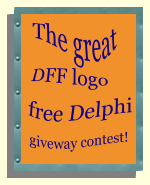What's New - October 2000
[Home]
|
October 30: A new Math Topic and program about Hashing is available. Not the corned beef variety, but based on the same idea. Here we are making a hash of a key to produce some new "hashed" key that is more useful than the original. In fact, the new key will be the index into an array of objects, pointing to the directly to the one we are looking for. (Well, almost always anyway, and we can handle the exceptions.) A very fast lookup when it can be used. October 27: Place a knight chess piece on a chessboard and make 63 more knight moves to visit every square exactly once. If you try it randomly, plan on spending a few million years. But there's a trick that makes it trivial for a computer (and even possible for a human) to solve the problem. Check out the Knight's Tour. (By the way, the Germans call them "springers" - that's pretty cool.) October 26: Graph Traverse starts the exploration of graph searching. In this case we are are trying to find the paths through an array of integers with the largest and smallest sums. Graph searching is important in game theory as a technique for solving or winning and one that will occur frequently here as we move to solve harder problems. October 22: Most All 3 is a program that should convince you, if you don't believe it already, that almost every integer has a "3" in it. October 19: Cards #2, a version of Cards1 with graphic card images is available for study and download. In addition to Shuffle and Deal buttons, we've added card back selection, drag/drop and turn-over features. Should be enough tools here to implement card games. Personally, I think I'll look for some card puzzles to implement now. Two programs in one day! Maybe I really do need to get a life. But I did kind of promise that I would post it this week, and this weekend is dedicated to honing my pioneering skills with the old muzzleloader. Cannon, an animated graphics program that lets you aim and fire a cannon at a target is available. Not very sophisticated, but at least it leaves plenty of room for user enhancements. October 16: Rotate a square, is a small graphics program that rotates a square about a point under user control.. It was written to figure out how to elevate the cannon in the Cannonball program coming next week. A little bit of trigonometry is used to rotate the four corners of the square around its center. Then it's just a matter of connecting the dots. October 14: Here's Primefactors1, a program to calculate primes, test for "primeness", or return prime factors of numbers up to 18 digits in length. We'll follow this up with some programs that use the unit developed here to solve some prime and factoring problems. October 12: A Delphi Techniques topic discussing parsing strings into words is up. A sample program which reads a text file and counts words can be downloaded for study. October 10: Towers of Hanoi puzzle, version 2 is available. This version builds on Version 1 by listing the moves required to solve the puzzle (up to 1000 moves - almost enough to solve the puzzle with 10 disks). This version introduces a TTowers object which will be expanded in the graphics version coming next. Cards #1 - the beginnings of a card playing system was also posted. This is a beginner's level program with about 60 lines of user written code. It shuffles, deals, and displays card text (Q-Clubs, 2-Hearts, etc.). Like the Towers program above, we introduce an object (TDeck this time) that will be expanded with the graphics version still to come. October 7: The Scientific Grapher program was posted today, our first advanced program! It contains about 3000 lines of code of which I only had to write 500 or so. The rest are in an included freeware component which parses and evaluates the expressions to be graphed. The program uses a TChart component that is not included in the Standard version of Delphi. To compile you will need Pro or Enterprise versions. But the executable code is available for download by anyone, with or without Delphi. Sample graph files are included for several simple and more complex plots. If you want to know what Freeth's Nephroid looks like, download this program. October 6: Posted Rotating Sums another little program that uses the permutation routines from Permutes1 to solve a puzzle. October 2: Permutes1 introducing permutations was posted today. It illustrates three different techniques for generating all possible arrangements of a set of numbers, two from other sources that are concise and difficult to understand and mine, longer but at least I can explain how it works. We also posted the second intermediate level program, Alphametics, which uses the permutation technique from Permutes1 to solve word arithmetic problems like BONG + BONG + BONG = GONGS.
|
